
The long-nosed horned frog, also known as the Malayan horned frog or Malayan leaf frog is a species of frog restricted to the rainforest areas of southern Thailand and Peninsular Malaysia to Singapore, Sumatra, and Borneo. However, records from Thailand to the Sunda Shelf may apply to another, possibly unnamed species.
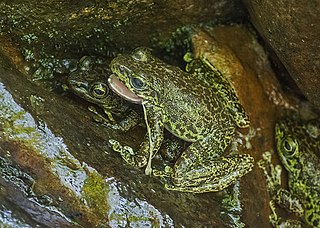
Amolops formosus, also known as Assam sucker frog, beautiful stream frog, Assam cascade frog, or hill stream frog, is a species of frog found in high gradient streams of northern India, northern Bangladesh, and Nepal, possibly also Bhutan, although these records may represent confusion between Amolops himalayanus and this species; the latest available IUCN assessment from 2004 treats A. himalayanus as a synonym of A. formosus.
Cardioglossa alsco is a species of frog in the family Arthroleptidae. It is endemic to Cameroon and is known from its type locality on southern slopes of the Tschabal Mbabo Mountains as well as from the Gotel Mountains, both in the Adamawa Region. Its range might extend into Nigeria. The specific name alsco is a patronym for the American Linen Supply Company (ALSCO). The company's German branch supported the expedition during which this species was discovered.

Astylosternus batesi is a species of frog in the family Arthroleptidae. It is found in Cameroon south of Sanaga River, Equatorial Guinea, Gabon, southwestern Central African Republic, the Republic of the Congo, and the extreme western Democratic Republic of the Congo (Mayombe). The specific name batesi honours George Latimer Bates, an American naturalist. However, its vernacular name is Benito River night frog, apparently in reference to its type locality, Benito River in Equatorial Guinea.
The yellow-bellied poison frog, yellow-bellied poison-arrow frog, or yellowbelly poison frog is a species of frog in the family Dendrobatidae. It is found in northwestern Colombia and east-central Panama.

Ameerega trivittata, formerly Epipedobates trivittatus, is a species of frog in the family Dendrobatidae commonly known as the three-striped poison frog. It is found in Bolivia, Brazil, Colombia, Guyana, Peru, Suriname, Venezuela, possibly Ecuador, and possibly French Guiana.
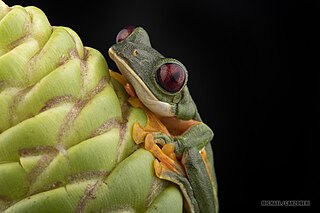
The gliding tree frog is a species of frog in family Phyllomedusidae. It is found in Colombia, Costa Rica, Ecuador, and Panama. Other common names are the gliding leaf frog, Spurrell's leaf frog, and pink-sided tree frog. The specific name, spurrelli, is in honour of British zoologist Herbert George Flaxman Spurrell.
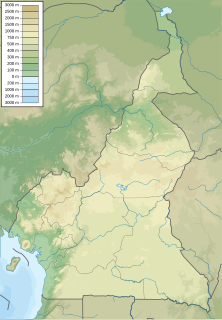
Alexteroon jynx is a species of frog in the family Hyperoliidae. It is endemic to the Rumpi Hills in southwestern Cameroon. The common name smooth egg-guarding frog has been proposed for this species.
Yunganastes ashkapara is a species of frogs in the family Craugastoridae. It is endemic to Bolivia and is known from the vicinity of its type locality in the Chapare Province and from Abra de la Cruz in the Manuel María Caballero Province. The specific name ashkapara is derived from Quechuan ashka meaning "a lot" and para for "rain", and refers to the very high rainfall in the region of the type locality.
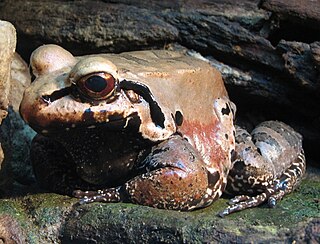
The smoky jungle frog is a species of frog in the family Leptodactylidae. It is found in Bolivia, Brazil, Colombia, Ecuador, Costa Rica, Panama, French Guiana, and Peru. Its natural habitats are tropical and subtropical moist broadleaf forests, subtropical or tropical swamps, subtropical or tropical moist montane forest, rivers, freshwater marshes, intermittent freshwater marshes, and aquaculture ponds.
Kalophrynus intermedius is a species of frog in the family Microhylidae. It is endemic to Borneo and is found in Brunei, south-central Sarawak (Malaysia), and Kalimantan (Indonesia). Common names intermediate sticky frog, Sarawak grainy frog, and Mengiong sticky frog have been proposed for it.
Kalophrynus subterrestris is a species of frog in the family Microhylidae. It endemic to Borneo where it is known from Sabah and Sarawak (Malaysia), although it is also presumed to be present in Kalimantan (Indonesia) and Brunei. Common names burrowing grainy frog and Labang sticky frog have been coined for this species.
Phrynobatrachus keniensis is a species of frog in the family Phrynobatrachidae. It is found widely in the highlands of Kenya. It is also recorded from Mount Meru in northern Tanzania, but this might represent a different species. Common names Kenya River frog and upland puddle frog have been coined for it.
Papurana garritor is a species of frog in the family Ranidae. It is endemic to New Guinea and widely distributed, found in both Indonesian and Papua New Guinean parts of the island. Common name Eilogo Estate frog has been coined for it.
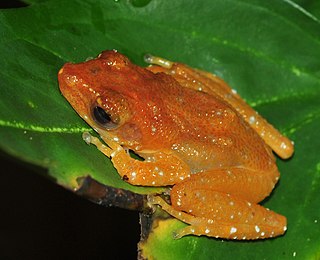
Nyctixalus pictus, also known as cinnamon frog, cinnamon treefrog, cinnamon bush frog, painted Indonesian treefrog, and white-spotted treefrog, etc., is a species of frog in the family Rhacophoridae. It is found in the Malay Peninsula, the Philippines, and parts of the Greater Sunda Islands.

Philautus bunitus is a species of frog in the family Rhacophoridae. It is endemic to Malaysian Borneo and inhabits subtropical or tropical moist lowland forests and subtropical or tropical moist montane forests and is threatened by habitat loss.

Philautus hosii is a species of frog in the family Rhacophoridae. It is endemic to Borneo and has been found at 1,351 m (4,432 ft) above sea level. The specific name of the synonym, Polypedates chlorophthalmus, refers to its "remarkable green iris", from the Greek for "green-eyed". Accordingly, the common name green-eyed tree frog has been coined for the species.
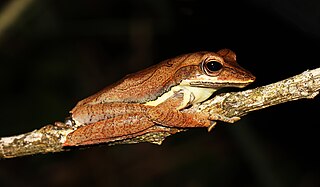
Taruga fastigo is a species of frogs in the family Rhacophoridae. It is endemic to Sri Lanka and only known from its type locality, Morningside Estate near Rakwana. Prior to its description in 2001, it was confused with Polypedates eques.

Polypedates leucomystax is a species in the shrub frog family Rhacophoridae. It is known under numerous common names, including common tree frog, four-lined tree frog, golden tree frog or striped tree frog. Many past authors have united it with the common Indian tree frog in P. maculatus, but today they are generally considered distinct species. In its native range, it is also called "white-lipped tree frog", but this name is otherwise applied to a species of true tree frogs.
Rhacophorus exechopygus is a species of frog in the family Rhacophoridae. It is found in the Central Highlands of Vietnam and in the adjacent Annamite Range in Laos. Its range may extend into northeastern Cambodia where suitable habitat should be present. The specific name exechopygus is derived from the Greek words exechos and pygos (=buttocks), referring to the infra-anal projection characteristic of this frog. Its common names are spinybottom tree frog and Tramlap flying tree frog.













